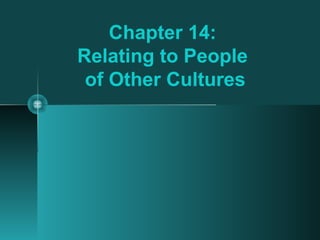
18 chapter14
- 1. Chapter 14: Relating to People of Other Cultures
- 2. Chapter Outline • Introduction • Developing Relationships: A Process • American Friendships • New Neighbors, Friends, and Acquaintances • Conclusion
- 3. Introduction One of the distinct pleasures of being a cross- cultural missionary is the joy of meeting numerous people of backgrounds radically different from one’s own. At the same time, it is also one of the frustrations. Developing relationships with people of other cultures takes a long time, and negotiating relational waters that are filled with eddies and undertows can be tricky.
- 4. Developing Relationships: A Process • Stage One: Who Are You? • Stage Two: Let’s Be Friends • Stage Three: Intimate Friendship
- 5. Developing Relationships: A Process • Whatever the culture, there is an ebb and flow in developing relationships. While each relationship may be seen as unique and following its own path, in general three phases may be seen in relationships across cultures: • Initial acquaintance • Developing friendship • Growth in intimacy • The separation between the phases may be fuzzy, and relationships can proceed both backward and forward, but those three phases typify progress in a relationship. Further, people may wander back and forth through all three simultaneously as a relationship develops.
- 6. Stage One: Who Are You? • Choosing friends: • Individualists believe the responsibility lies in each person; friendships are voluntary associations. • Collectivists believe the responsibility lies in kinship and social obligations; friendships are something one is born into. • Two barriers to moving through this stage: • Stereotypes that need to be overcome • A question to be answered: Are you enough like me to commit to a deeper relationship?
- 7. Stage Two: Let’s Be Friends • This stage of relationships requires both parties to consider the risks of changing enough to accommodate each other. Both must make some compromises if the friendship is to be mutually valued. • Barriers to be overcome: • Growing emotional openness • Conflict resolution process that both feel is fair
- 8. Qualities Necessary for Effective Interpersonal Relationships • Kindness • Patience • Valuing people • Politeness • Thinking the best of others • Persistence
- 9. Stage Three: Intimate Friendship • This last stage is reached in a relationship only when at least one party chooses to focus on developing the friendship. • Ideals of intimacy vary across cultures: • The collective person identifies intimacy in terms of the amount of time spent together, the relative lack of privacy, mutual dependence, and issues of face. • The individualist may prefer to maintain a level of privacy and independence that seems distancing to the collectivist. • Any intimate friendship will sooner or later have to face the need for forgiveness.
- 10. Seven Realities of Cross-Cultural Friendships (Hill 1993, 266–68): • It must be intentional. • It requires proximity. • It must appreciate differences and similarities. • It will cross economic classes. • It involves vulnerability. • It must be selective. • It must be flexible.
- 11. American Friendships • Americans tend to choose their friends based on spontaneity, mutual attraction, and warm personal feelings. • American friendships, though starting fast, tend to be relatively shallow in comparison with friendships in other cultures. • Americans’ relations with their friends are kept separate from work or social obligations. • American friendships are formed in shared activities.
- 12. New Neighbors, Friends, and Acquaintances • Learning to live as a good neighbor is an important missionary skill. • Qualities of neighborliness will vary from culture to culture. • One of the early adaptations that missionaries must make is learning what the new “neighborology” is: • What makes for good neighbors • What bothers people in the neighborhood • What roles there are for the stranger who comes to a new neighborhood
- 13. Conclusion • Discipleship is built on relationship. Relational values and skills are culturally learned, and the wise cross-cultural worker will invest significant time in learning how friendships are developed in that culture so that he or she can disciple well. • In the end, developing deep relationships in the host culture is not optional for missionaries who want to faithfully call others to worship Christ. • The question is not whether missionaries develop significant relationships; it is how well they do it.